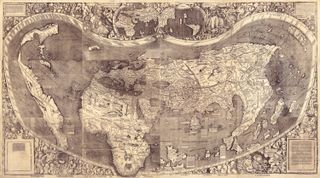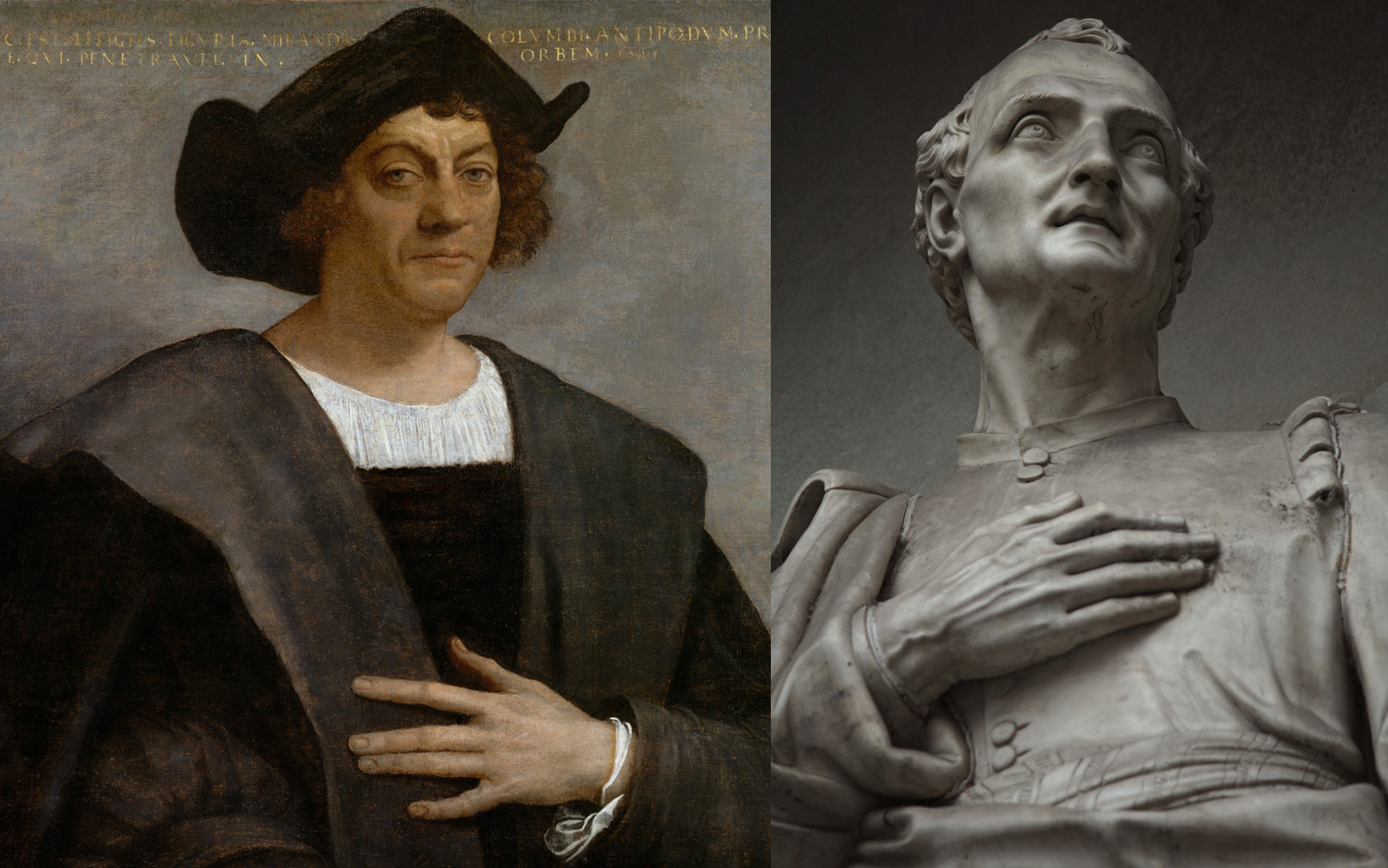what was the main reason columbus sailed to the americas
Columbus 'discovered' the New World … and so why isn't America named afterward him?

Christopher Columbus famously sailed the ocean blue in 1492, so why isn't the New Earth named later on him?
The answer has to do with Columbus' reputation at the time Europeans named the newfound continents, every bit well every bit a highly successful publicity entrada led past the Italian explorer Amerigo Vespucci, said Matt Crawford, an associate professor of history at Kent Land University in Ohio.
In addition, Columbus maintained until his dying 24-hour interval that the new land he had discovered was, in fact, Asia, Crawford said. In contrast, Vespucci was one of the starting time, if not the showtime explorer to declare that the New World was an entirely newfound entity (at least to the Europeans at the fourth dimension).
Related: How far away is the horizon?
Columbus, born in 1451 in Genoa, Italy, moved to Portugal in 1476 to start a mapmaking business. At the time, chosen the Age of Exploration, Portugal was a leader, having already discovered the Madeira Islands and the Azores in the Atlantic Ocean and sailed down part of Africa's western declension.
Yet, what Europe actually wanted was a route to India. The Ottoman Empire had blocked European access through Constantinople, as well equally across North Africa and the Red Sea. Columbus wanted a slice of the action and proposed, equally others had, that Asia could be reached by sailing w. (Back then, people knew the Earth was round. The misperception that people thought it was flat was introduced past the American essayist Washington Irving, best known for writing "Rip Van Winkle" and "The Legend of Sleepy Hollow," who popularized the so-called "apartment Earth" controversy in his 1828 book "The Life and Voyages of Christopher Columbus.")
Subsequently Portugal rejected Columbus' idea — not only considering he wasn't well connected just also considering they (rightfully) thought that he had underestimated the distance between Europe and Bharat — he took his plan to Spain. It's unclear how successful the Spanish thought Columbus would be, which may explain why they agreed to give him so much if he found a route to India. "He'due south promised a lot in render; a adequately substantial portion of the trade and wealth that would come out of more direct contacts with Asia," Crawford said. "He'south promised the grand title 'Admiral of the Body of water Sea' and 'Viceroy of the Indies.'"
What happened next made history; Columbus sailed straight into the Bahaman island of Guanahani. During the four voyages Columbus made to the New World, he prepare foot on islands such as Cuba, Hispaniola and the coasts of Central and Southward America. Simply Columbus adamantly repeated that he had found Asia, possibly to ensure that he would go along the wealth and titles that Spain had promised him, Crawford said.
This stance fabricated some of Columbus' contemporaries view him equally duplicitous and not credible, Crawford said. Meanwhile, the Portuguese explorer Vasco da Gama traveled from Portugal to Bharat and back again past sailing around the Greatcoat of Skilful Hope in southern Africa from 1497 to 1499, meaning Portugal had trounce Spain in the race to India.
"The Spanish crown was apparently and then unhappy with Columbus' failure to get to Asia and also this mounting reputation he was getting for duplicity, that was part of the reason why they sent an agent to the Caribbean to arrest Columbus and bring him back to Spain," Crawford said. "He was later stripped of his titles."
Related: Photos: Christopher Columbus likely saw this 1491 map
The messages
In 1493, Columbus wrote a letter to 1 of his supporters, Luis de Santángel, nearly his discovery. This letter was later reprinted and read by many people.

Just messages from the Italian Vespucci (1459-1512) were far more popular. Vespucci, who sailed under the Portuguese flag, took his showtime trip to the New Globe in 1499. As mentioned, Vespucci recognized that these lands weren't Asia, but rather new continents. (Of note, "these revolutions are hard to discern in [Vespucci'due south] published letters," then information technology's possible that others saw more significant than he meant to convey, according to a 2006 study in the journal Past and Present. For case, Vespucci calls the state mass a "continent," but this could hateful "mainland," scholars say.)
Regardless of what Vespucci meant, his messages near the New World to his patron Lorenzo de' Medici became best sellers across Europe. "Information technology wouldn't be unreasonable to say that his letter, much more so than Columbus' letter, [helped] people learn most this New World," Crawford said. In these letters, "Vespucci played up the sensational aspects of the sexual and dietary customs of the inhabitants and the novelty of his ain scientific observations," Christine Johnson, an associate professor of history at Washington University in St. Louis, wrote in the 2006 study.
These letters, in turn, influenced a famous mapmaker. In 1507, the German language cartographer Martin Waldseemüller created the first map to utilise the name America. However, this name hovered over Brazil. "Waldseemüller doesn't really label the whole region as America," Crawford noted.
As for why the land mass was named "America" and not "Amerigo," an introduction in a pamphlet that Waldseemüller wrote for the map notes that "Inasmuch as both Europe and Asia received their names from women, I run into no reason why anyone should justly object to calling this part Amerige, i.e., the state of Amerigo, or America, after Amerigo, its discoverer, a man of cracking ability."
In reality, Portugal had already named Brazil "Ilha de Vera Cruz," or "Island of the True Cross," but information technology's possible that Waldseemüller didn't know that at the time, Crawford said.
In subsequent 1513 and 1516 maps, Waldseemüller stopped using the name America and instead used the names "Terra Incognita," and "Terra Nova," possibly considering he realized that it was Columbus, and non Vespucci, who had arrived first in the New Earth, Crawford said. But past then it was too late; other mapmakers had already copied him and spread the proper noun far and wide. The name America was firmly rooted by the stop of the 1500s, Crawford said.
Granted, naming a new land is largely a symbolic gesture, given that the Europeans didn't command these areas for some time.
"This whole enterprise of making maps and assigning European labels and names to places that Europeans accept no business labeling or naming, that's role of their endeavour to have possession of these lands," Crawford said. That's the credo of colonization — that these are our places, we've given our names to those places."
Originally published on Live Scientific discipline .
Source: https://www.livescience.com/63778-why-america-not-named-for-columbus.html
Enviar um comentário for "what was the main reason columbus sailed to the americas"